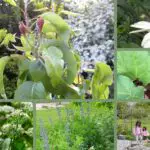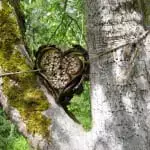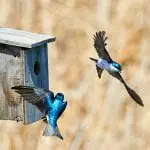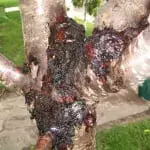Learn how to choose the best companion plants for your fruit trees, build simple and effective guilds, and avoid common Read more
How to Protect Fruit Trees From Frost - 3 Ways

If you are growing fruit trees, spring is a time of hope. As the weather warms and the days get longer, your fruit tree's buds will break open. Blossoms and leaves will emerge, and if pollination is successful, baby fruit will form.
But what if bud break happens too early in the season? What if that warm spring weather is followed by a deep frost? Well, fruit tree blossoms can die and tender young leaves may turn to mush and that can damage tree health and dash your hopes for a good harvest.
In this article, we'll explore how to protect your fruit trees from frost damage. With these practical strategies you can keep your tree and your harvest healthy even if there is a late spring frost. So, let’s dig in!
Critical temperatures for frost damage on fruit trees
Dr. Kevin Folta, a professor in the Horticultural Sciences department at the University of Florida, knows all too well the perils of late frosts. On a cold March night in 2022, he found himself on "frost duty" when a frost warning was issued for his wife Natalia's farm. The stakes were high as peaches had already formed on the trees, and mulberry trees had leafed out.
Kevin knew that the critical temperature for frost damage on stone fruit trees is 27°F (-2.8°C). If the temperature dips below that temperature, fruit tree blossoms can die and growing fruit can be damaged. So, Kevin sat in his car in the orchard all night, monitoring the temperatures. If the temperature dipped too low, he would work to protect the trees.
At 6 am, it was still just 36°F (2.2°C). Kevin thought the risk of frost damage had passed so he drove home and went to sleep. But while Kevin was sleeping, the temperature went down to 27°F for two hours – long enough to kill fruit tree blossoms and damage the growing fruit. This brief frost destroyed several thousands of dollars’ worth of fruit.
Understanding Why Fruit Trees need Frost Protection
To understand why frost damage on fruit trees can be so devastating, we need to understand a little biology. Fruit trees, including apple, cherry, pear, plum and apricot trees, can be very hardy, but they have their vulnerabilities. When they are dormant during the winter, their branches are bare, and their buds remain tightly sealed. This helps the trees resist the cold. But as the days warm and buds open, young leaves and blossoms become exposed and vulnerable to the frost.

Frost can damage fruit trees in various ways:
- Blossoms can die and as a result, the tree will not produce fruit that year.
- Leaves can die, making photosynthesis difficult. As a result, your tree may not be able to support healthy tree growth and fruit production.
- Branches can die if the frost happens when the sap is flowing. That’s because the cold snap will cause the sap to freeze and expand, causing plant cells to burst. This can lead to branch dieback, stunted growth and even tree death.

Ok, so winter fruit tree damage can be severe! But that damage can be avoided, if you are prepared. Here are some options:
#1: Learn how to cover fruit trees from frost
If you are prepared in advance, it’s not hard to cover your fruit trees to protect them from frost but this is a technique that is ideal for smaller fruit trees that have been pruned annually to keep them compact.
To do this, you will rig up a two-layer, umbrella-shaped covering to insulate your fruit trees during a cold snap. The first layer will be made of fabric using old sheets or blankets. And the second layer will be plastic using a tarp or plastic sheet.
Ensure that the sides of the trees are open to the air for good air circulation. And set up your covering using the instructions below when the weather is expected to dip below 27°F (-2.8°C).
Here’s why covering your fruit trees to protect them from frost works:
- The earth absorbs heat during the day when the temperature is warmer.
- At night, when temperatures drop, this heat is released.
- The umbrella shaped fruit tree frost cover will trap that warmth under the canopy.
- This warmth shields your tree, preventing frost damage to blossoms and fruit.
- For additional warmth, you can place buckets of water underneath the tree’s canopy. The water will be warmer than the ambient temperature and, like the soil, will release that heat over night.

Step-by-step instructions for covering your fruit tree to protect it from frost
Materials You'll Need:
- Wooden stakes or metal posts (number depends on tree size)
- Fabric (old sheets or blankets)
- Plastic tarp or frost cloth
- Twine or rope
- Scissors or cutting tools
- Hammer or mallet
- Optional: Clamps or clips for securing materials

Directions:
- Assess Tree Size and Shape: Determine the size and shape of your fruit tree. You'll need enough fabric and plastic to cover the entire canopy without touching the leaves or branches.
- Position Stakes or Posts: Place wooden stakes or metal posts around the perimeter of the tree, evenly spaced. The number of stakes/posts needed will depend on the size of your tree. These will serve as support for the covering.
- Create the First Layer (Fabric): Drape the fabric over the tree's canopy like an umbrella. Ensure it covers the entire canopy without touching the leaves or branches. Secure the fabric to the posts using twine, rope or clamps.
- Add the Second Layer (Plastic Tarp): Place the plastic tarp or frost cloth on top of the fabric layer. This second layer helps trap heat and insulate the tree. Secure it to the posts using twine, rope or clamps. Make sure the sides of the tree are at least partially uncovered to ensure ventilation.
- Store Materials: After the frost threat has passed, carefully remove the covering, store the fabric and plastic for future use, and ensure the tree has adequate access to light and air.


#2: Prevent blossoms from freezing by protecting the tree with a spray of water.
Emily Harding is a home grower in zone 8A in South Carolina. She grows peaches, plums, mulberries, Asian pears, and other trees in her garden. In recent years, there have been early warm spells that cause her trees to emerge from dormancy and blossom. But then often these warm spells are followed by deep frosts.
So Emily is prepared. With a deep frost is in the forecast, Emily will set up a sprinkler on a ladder near one of the affected fruit trees. Then, she will turn on the sprinkler before the temperature reaches freezing. If she waits too long, water can freeze inside the hose or tap, preventing water flow.
Then Emily will leave the sprinkler on overnight, and the blossoms will become covered with a protective layer of ice. The hope is that the ice will insulate the blossoms, keeping them at 32 degrees Fahrenheit (0°C). So, when the temperatures dive even lower, the blossoms will be protected.

Here’s why this works:
- When water comes out of the tap or well, it carries some heat. When this slightly warmer water lands on blossoms, branches, fruit or leaves, it imparts heat to them, safeguarding them from freezing.
- This insulating effect continues when that water starts to solidify and turn to ice. As the water freezes, the water molecules release energy in the form of heat, creating a thin film of water around blossoms and fruit, followed by a thicker layer of ice.
- As more water is sprinkled on, this fresh ice releases more heat, further protecting your tree’s blossoms and branches.
Kevin Folta says this can be an effective strategy, but there is a caveat.
“You do have to think about it and watch it carefully,” says Kevin. After all, too much ice can break branches on young trees.
Here are the steps to protecting fruit trees from frost with water.
Materials You'll Need:
- Sprinkler or oscillating sprinkler system
- Garden hose long enough to reach the tree
- Access to a reliable water source
Steps:
- Check the Weather Forecast: When the weather threatens to dip below 27°F (-2.8°C) it’s time to set up your sprinkler!
- Position the Sprinkler: Place the sprinkler or oscillating sprinkler system near the fruit tree you want to protect. Position it so that it covers the entire canopy of the tree, including the branches and blossoms. Hook up the garden hose to the sprinkler.
- Connect the Hose: Attach a garden hose to the sprinkler and ensure it's long enough to reach a water source. Connect the other end of the hose to a reliable water source, such as an outdoor faucet.
- Adjust Water Flow: Adjust the water flow rate on the sprinkler to achieve a fine mist. The goal is to create a delicate ice coating on the blossoms and tree, which helps insulate them from the cold.
- Begin Misting: Start the sprinkler when the temperature dips below 27°F (-2.8°C). Continue misting throughout the night to maintain the ice coating.
- Turn Off the Sprinkler: As dawn breaks and temperatures rise, turn off the sprinkler to allow the ice to melt naturally. The ice will have served its purpose in protecting the blossoms from frost damage.
- Repeat as Needed: If frosty nights persist or return, repeat the process on subsequent nights to ensure continuous protection for the fruit tree blossoms.
Fruit Trees
That Thrive
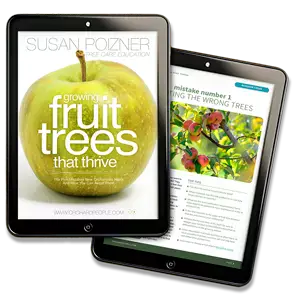
#3 Additional Fruit Tree Frost Protection Strategies
Leslie Mapes-Wade grows fruit trees in the North Georgia Mountains. This year, her plums blossomed more than three weeks early and that was followed by sustained temperatures between 23-28 degrees Fahrenheit (-5—2°C). It was devastating. Leslie lost all her plums, peaches, and most of the pears.

Her strategy going ahead is to consider planting fruit trees that will be more frost resistant and easier to cover and protect in the years to come.
“We're moving to dwarfing, rootstocks and late blooming cultivars, so that we can try more aggressive frost prevention methods. We're trialing a bunch of cultivars to see what works in the coming years. Then we'll narrow it down to the ones that perform best"
So, if you are planting new fruit trees, there are a few considerations to help you avoid the problem of fruit tree frost damage in the future.
- Choose frost resistant fruit trees and cultivars: When planning your orchard, research and select fruit trees that are known for their cold hardiness and ability to withstand late spring frosts. Learn how to do this in our course Researching Fruit Trees for Organic Growing Success.
- Plant trees near a body of water: Planting fruit trees near a body of water, such as a lake or pond, or even a swimming pool, can provide a degree of natural frost protection. Bodies of water can moderate temperature extremes, releasing stored heat during cold nights and absorbing excess heat during the day, reducing the risk of late spring frosts damaging blossoms.
- Plant trees near south facing walls: The wall absorbs heat during the day and radiates it back during the night, creating a slightly warmer environment for the trees. Stringing some incandescent Christmas lights on the tree can provide extra heat on really cold nights. Be sure to use outdoor-rated lights and avoid LED lights, as incandescent lights produce more heat.

Conclusion: What is the best frost protection for fruit trees?
In the end, the best frost protection for your fruit trees is the one that you can quickly and easily put into action. As a small-scale grower, being prepared is key. Make sure you have all the necessary tools and materials on hand, such as sheets, tarps, and a hose with a sprinkler. Don't forget to think ahead and plan how you will secure your covers to prevent them from blowing away.
Remember, protecting your fruit trees from frost is simple when you have a solid plan in place. To learn more about frost protection and other fruit tree care tips, check out the podcast linked below. And for a comprehensive guide to successful fruit tree growing, consider signing up for one of OrchardPeople.com's five-star rated online courses.
With a little preparation and knowledge, you can enjoy a fruitful harvest year after year. Happy growing!

Susan Poizner
Learn more about Susan on the about us page.
